#i DO have a small expansion for the new members that includes hermits but i havent decided on a natsumi yet. suggestions are appriciated
Explore tagged Tumblr posts
Text
hello beautiful people of tumblr.would you care to hear about this beautiful au ive come up with

boatem as liella (MORE ACTUAL THOUGHTS UNDER THE CUT/A RUNDOWN OF WHOS WHO AND WHY)
mumbo as ren - ren is the school concil presiendet and mumbo is ceo… its like the same almost - ren is high class which means RICH!! mumbo is the RICHEST HERMIT!! - generaly formal guys that are very silly - i think like.cannot explain it but like if mumbo saw something serious he would act like he didnt see it (ren saw chisato was going to leave the school she acted like she didnt see it…) - "Her favorite saying is, "Never forget why you started."" <-mumbocore - ren got addicted to video games? MINECRAFT? pearl as chisato - pearl would work at a food truck in my head it feels fitting - she wold most DEFINITELY be the one to train the other guys with dancing & other stuff - gossip girl - okay so chisatos whole thing in ep 5(?) where she was getting left out when kanon keke and sumire were with sunny passion because she was so involved with the idol group but wasnt actually an idol herself ? yeah pearl coded impulse as kanon - shes like. . . just normal girl and impulse is just normal guy but theyre both actually weird (/AFF POS) - impulse would like .. . want to get into something and DESERVE to get into said thing but then absolutely die from anxiety during the audition / interview and not get in - the impulse and scar dynamic that comes from them being kanon and keke.. . . . - I DONT HAVE ANYTHING ELSE I DONT KNOW ENOUGH ABOUT IMPULSE scaar as keke - scar biggest hypeman to anyone ever i think " this is my little guy and if you dont clap and cheer for him ill blow this place to the ground " energy - ALL OF KEKE ENERGY IS SO SCAR!! - "NO IDOL GROUP ALLOWED?! THIS IS PUPOSTERUS! [IMPULSE]. WE NEED TO QUIT THIS SCHOOL RIGHT NOW" - completely hyped up to do something but then when it comes to doing it dies of anxiety but then bounces back instantly - keke images that are scar coded to me below - they both would and have chased down someone




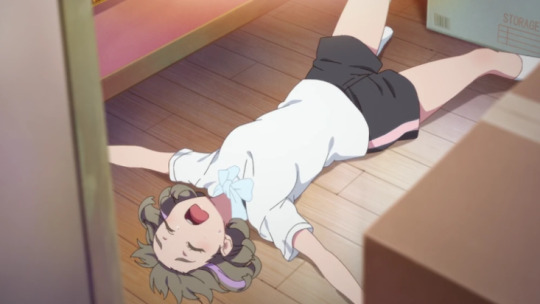

grian as sumire - grian's the kind of guy to kidnap someone take them to his house/shrine and try to preform some stupid magic to get them to forget something that happened but also is actively learning the magic while he does it - SUMIRES LIKE!! the thing where she says "GALAXY!!" thats a bit grian coded to me i dont know what hed say though - grian WOULD stand out in the rain desperate for someone to team up with him just like how sumire stood out in the rain desperate for someone to scout her (cough cough SECRET LIFE cough cough) - like with sumire's thing about how when she was a child she only got side parts in stuff and she wanted to be the center in liella but then when they voted for kanon to be the center and she quit…. grian coded - grian wouldve done something embarrassing as a child thats everywhere on the internet if you search hard enough and his friends tease him about it THOSE ARE ALL MY THOUGHTS IF YOU KNOW ANYTHING ABOUT ANY OF THESE HERMITS AND ANYTHING OF LIELLA REBLOG WITH THOUGHTS AND ADDITIONS IN THE TAGS ILL ADD TO THE POST !!!!!!!!!! or send an ask too
#timmister post#hermitblr#this is the craziest idea ive come up with but i might just be cooking#i DO have a small expansion for the new members that includes hermits but i havent decided on a natsumi yet. suggestions are appriciated#but currently its#joel = mei#cub = shiki#etho = kinako#oh and doc and ren are sunnypa#anyways everyone should watch love live superstar but the s2 writing is kinda bad.just to be warned#s1 is awesome though#love live#liella#boatem#grian#mumbo#gtws#pearlescentmoon#impulsesv#hey just putting it out there i think they would absolutely rock the start!! true dreams outfits wink wink nudge nudge
45 notes
·
View notes
Text
Is Slab City, California the Last Free Place in America?
Sentry box from World War II’s Camp Dunlap, at Slab City’s perimeter. Photograph by Donovan Wylie.
by Charlie Hailey | November 2, 2018
When the alert pinged on my phone, I thought of Austin and his house of wooden pallets. A “wall of dust” roiled toward Slab City and other “impacted locations” in California’s Imperial County, and the National Weather Service warned: “avoid outdoor exposure.” It was an official weather bulletin for an unofficial place. An advisory with no remedy, because with pallets for walls there is no inside.
Now in its seventh decade, Slab City is a longstanding but chronically impermanent settlement built on Camp Dunlap, a decommissioned World War II training camp. It is an informal community of squatters, snowbirds, homeless residents, veterans, and artists like Austin, all making their homes in this unhomely desert environment wedged between an active gunnery range and the Imperial Valley’s industrial agriculture.
Leftover from the military camp, the basic elements of a town are here: roads, reservoirs, sewers, slabs, and foundations. After the camp was disbanded in 1946, the eponymous concrete slabs were left behind when the wooden buildings moved to Niland, the nearest town, four miles away. The slabs that remain today are cracked and partially covered with sand, and the camp’s original roads are pocked with holes and rutted with tank tracks. The million-gallon cisterns are empty; manholes have been filled in and their covers salvaged long ago. This residual infrastructure provides a backdrop to understand how people make homes in extreme places and how the things people make stand up to time, other people, and dust storms.
Off the grid, living in what is often called the “last free place,” Slab City’s residents measure the durability of their freedom in what they build. In structures like houses of wooden pallets.
I met Austin on one of my trips to Slab City with the Irish photographer Donovan Wylie. We wanted to understand the architecture of this place and its residents’ struggles with adaptation and resistance. When the weather alert came through, a year after my most recent visit, I didn’t know exactly how the storm would affect Austin’s pallet structure, and I wasn’t sure which version of pallet architecture would sift the wall of dust, or even if its architect was still there.
Wearing sandals made from two-by-four blocks of wood, Austin first approached us with a clipboard to ask if we’d like to see the three-level A-frame he was building. He walked us through the ground level where couches and chairs filled a shady living area on the ground. Further up, he had a workshop dedicated to hacking the proprietary charging systems of cordless tools. Magazines of AAA batteries sprayed out of the opened handles of drills and saws, waiting for their solar panel charge. Up above, a communal sleeping loft looked out through pallet frames toward the Algodones Dunes and the invisible Mexican border to the south, and westward toward Salvation Mountain and the Salton Sea’s dusty veil. Between slats to the east, we could see plumes of smoke rising from ordnance that had been dropped on the bombing range.
Slab City is here because it is a so-called Section 36. In America’s westward expansion, the National Land Ordinance of 1785 and subsequent land acts, including California’s 1853 survey, overlaid the land with a grid and divided each township into 36 sections. In this system, every township had two square-mile plots—Section 16 and Section 36—reserved for public education. Many have been sold by states to help fund schools, but this particular Section 36 has lingered as a small piece of public land, a forgotten square of desert atop East Mesa along the Imperial Valley’s ancient shoreline.
In the early 1940s, the Navy saw strategic advantages in the plot’s remoteness and its similarities to North Africa’s war theater. And so the U.S. military paid California $3,810 to install Camp Dunlap, the only revenue the state has ever received from this piece of land.
When the military moved out, migrant farmworkers harvesting creosote moved in, and Slab City’s informal settlement began. Despite pressures from developers and state officials concerned with liability, this Section 36 persists as a residual piece of Manifest Destiny where public land hosts private aspirations, rights meet hardship, and makeshift dreams ride the desert sea like concrete slabs on sand.
On Austin’s clipboard were sketches that carried more than just plans for shelter. These designs harbored visions and hopes. They delineated the fugitive aspirations of an artist, a resident of Slab City, a member of a wider community founded on an ethic of reuse. Residency on the slabs can be as fleeting and vulnerable as the materials at hand: cardboard, palm fronds, shade cloth, and pallets are themselves transient. And when I returned less than five months later to visit Austin, his original pallet structure was gone, and another had risen across the road.
If the previous project was the house of an idealist, a DIY hacker, an improviser, then this new one was the refuge of an ascetic, a hermit, a master geometer. If the first had been an exercise in communal living cast within a builder’s yard and its organized riot of materials, this second structure was a remote outpost, its peaked arch of pallets recalling the praying hands of Jerome, isolated in an austere sand and gravel lot. The frame of this inverted V rose twenty feet into the desert sky, pushing the modules of soft wood to their material limits so that the middle two pallets of each side sagged a little under their own weight, as if weary from traversing borders, supporting goods, and delivering things in the 21st century’s global supply lines.
A pallet A-frame structure, the predominant building style in Slab City. Photograph by Donovan Wylie.
Now, this frame (is it a pointed version of St. Louis’s arch and a smaller gateway to this vestige of American frontier?) rises over a box formed by 28 other pallets, making room for its resident and, at the same time, presenting another experiment in living that tests the limits of “free,” within what public land and available materials might offer.
Where do you go in a dust storm when the last free place is already your refuge of last resort? How do you avoid exposure in a place that is already fully exposed? Build what you will, with the materials you have. Each of Austin’s pallet structures embodies the independence of building up and tearing down at will. But in something like a dust storm, this self-determination reaches its limit, and freedom becomes as porous as a pallet’s slats.
Slab City’s residents have been displaced from elsewhere. (Austin came from the city he’s named for.) Some arrived here by choice, but many others came here, seeking to escape forces beyond their control—whether economic, societal, or political. And the dust storm itself is a function of environmental degradation that began with the gridding of a continent, and continued with projects to irrigate the valley, triggering the calamity that formed the Salton Sea, which now issues toxic dust from its retreating shores.
Despite its remoteness and insularity, the last free place can’t escape these legacies. (In fact, it may be at their epicenter, just as it straddles the San Andreas Fault.) In some ways, Slabbers follow in the footsteps of the soldiers who trained here because they too are training to live in the desert. And before the first slabs were poured, the Navy set up a field lab to test the casting of concrete in extreme temperatures, nearly 120 degrees in that summer of 1941. Residents of Slab City now test the idea of freedom in a laboratory of their own making.
No reports followed this particular storm, but any snowbirds who lingered on the Slabs for the summer season would have recognized blizzard conditions as yellow clouds of sand and dust blotted out the sun, lowered temperatures, and reduced visibility to a few feet. Drifts of sand likely pressed into Austin’s second pallet structure, as dust layered onto cans of food, chairs, tables, tools, and sketchpads, leaving a gray coating on every surface as if it had been there for hundreds of years. Slabbers who had cars or trailers would have retreated into their sealed interiors, while others like Austin would rely on a pallet’s imperfect windbreak to avoid sandblasting that can last for hours.
The wall of dust will be followed by other storms, just as plans to close Slab City will be proposed and then postponed, and somehow this place will endure. Freedom may not be free, but when it manifests itself in the solidity—even if makeshift—of this architecture, like Austin’s pallet structures, hidden identities become apparent. Each resident brings their own admixture of need and desire and curates an equally aggregated version of ‘last free place.’
Out here on the slabs.
Source: http://www.zocalopublicsquare.org/2018/11/02/slab-city-california-last-free-place-america/ideas/essay/
1 note
·
View note
Text
Elder Druid, Barbarian Hermit, Satlan, and Slowbro Play Coventry
~By Reek of STOOM~
Photos by Luke Orchard
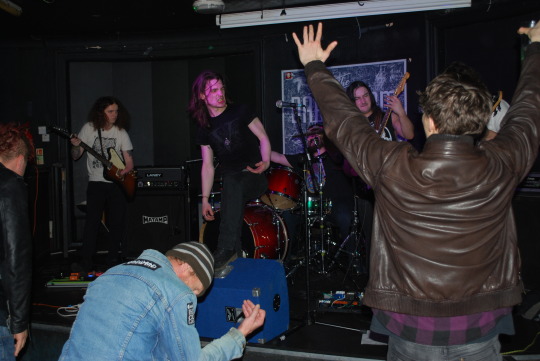
Friday, November 29th, at The Phoenix in Coventry, England
On the coldest night of the year so far, we ventured into the frost and made our way to the well-renowned Phoenix venue in the heart of Coventry to witness a four-band spectacle organised by Heathen Mirth Promotions out of London, UK. The venue itself is impressive and inviting: traditional pub downstairs with the live area above and an expansive beer garden.
SLOWBRO
Split (With Those Amongst Us Are Wolves) by Slowbro
First up on the bill were SLOWBRO, a three-piece local band who I hadn't encountered before and who surprised us with their dexterity and musicianship: A Stoner/Doom/Progressive crossover with heaps of energy and enthusiasm that won over the small but rapidly-filling room. After their set, I caught up with the members, James, Sam and Zeke for a quick chat.

Hi guys, you're new to the Doomed & Stoned radar, please tell us a little about yourselves.
Sam (guitars): "Well, James & I knew each other from the area and we both had guitars gathering dust in our rooms, so we decided to do something with them. We met up in a practice room once every two months or so, found a slot on a gig, came up with a name and just took it from there."
James (guitars) pipes in: "People started asking us to come back. We kept telling them no, but..." and laughs.
So why have you kept such a low profile on social media?
Zeke (drums) replied: "These guys just like to go abroad for three years or so" and laughs. "We're not trying to be the next big thing, just going about it and seeing what happens".
You had a split release out last year. Are there any other releases?
Sam: "Yes we had a full album out in 2018 called 'Nothings,' recorded locally and released on a small local label Creature Lab Records."
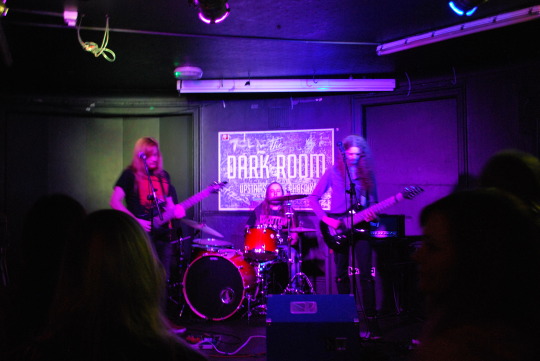
Are you signed to a label now?
James: "We're not tied to anyone long-term yet, we're just hoping to make our next album and see if it gets any interest."
Looking ahead to 2020, what plans do you have?
Zeke: "To play outside Coventry."
James: "We want to get our next album recorded - just get back into the studio and put down all the new stuff we've been working on."
You really impressed me with your style, Who are your influences?
Sam: "Sleep, Kyuss, Electric Wizard, first 2 Black Sabbath albums.." James interjects; "Christina Aguilera" and the three of them collapse, laughing. "Old School riffing, classic stuff, you know?"
What's your long-term ambition?
James: "Just to give people something good to listen to and get them to come out and see us."
Final question: What was the last piece of equipment you had to kick to get working again?
Sam creases: "The amp we borrow from Steven Bennett for every gig. We DO take care of it, honest!"
James: "We want to thank you and Doomed and Stoned for all your support. It means a lot."
No problem guys, thanks for talking to me and good luck for next year.
SATLAN
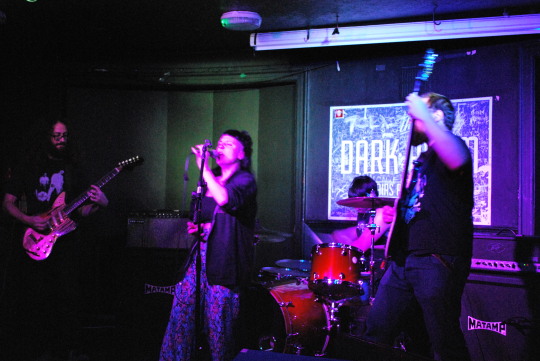
Next up on the bill were SATLAN, a four-piece outfit based in London and fronted by erstwhile Dead Witches vocalist Soozi Chameleone. The band are seriously tight and their drummer is a superstar. Soozi herself was having an off night, but still delivered a powerful performance despite not feeling at her best. Musically, a combination of Dead Witches and Alunah in style, but Satlan have a distinct Sabbath-esque motif generated by guitarist Roy Nadel. I caught up with Roy and bassist Alex after the set.
Firstly, the name Satlan, where did that come from?
Roy: "It's actually Hebrew slang for 'Stoner', someone who is too lazy - it fits our style."
Are you originally an Israeli band?
Alex: "No, we're from all over the place. Roy is Israeli, I'm Russian and Jake (drums) is Malaysian. We all got together in London and just started jamming, so we're an International mix. Roy and I have known each other since we were 16, playing in various bands together in Israel's Punk scene - Roy was actually a drummer in one of our bands! Our current drummer, Jake we found playing in thrash metal band THE BLEEDING and we knew straight away we wanted to work with him. I remember saying I wanna work with this guy!"

Do you have any recordings planned in the near future?
Roy: "We've just recorded an album. it's in the mixing stage right now and it'll be ready sometime in the next couple of months. We also have a gig with Church of the Cosmic Skull coming up in February and we're planning a UK tour, including a few dates in Scotland around April."
Final question: what was the last thing you kicked to get working?
Alex: "My cat." They both laugh.
Roy: "No animals were harmed really - we both have cats and we love them."
BARBARIAN HERMIT
Solitude And Savagery by Barbarian Hermit
BARBARIAN HERMIT are no strangers to us, having been included on our recent England compilation. Manchester's finest took to the stage around 10pm and proceeded to blast the eardrums out of the room with their signature Stoner/Sludge crossover. Compelling frontman Ed Campbell is a madman on stage and the most heroic poser since Bruce Dickinson! The dual guitar assaults from Mike 'Big Daddy Reeg' Reagan and Rob 'Spadge Fafner' Sutcliffe are ferocious and tighter than drainpipe jeans. After a blinding set, I caught up with the lads in the pub's pool room.
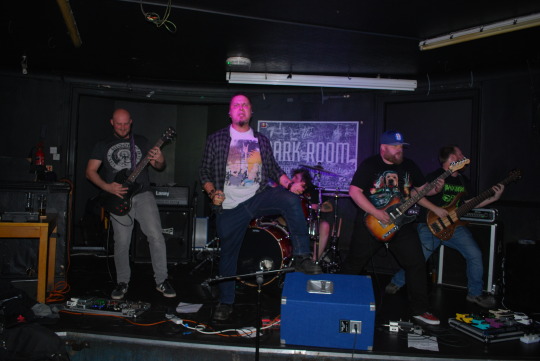
Thanks for attending the interview, tell me - how did you hear about the job?
Ed: "Well we had an email from a guy saying he was gonna pay us from a Somali bank account if we played. He said he wasn't a pirate. Seriously though, Heathen Mirth Promotions got us onto this and we've really enjoyed sharing a stage with everybody."
Since the Doomed and Stoned in England appearance, what's been happening?
Mike: "We opened for Bloodstock during the summer, that was a great laugh and we had a mini-tour in Edinburgh, Carlisle and the north with Widows and Drudge in October, then joined up with this lot for the dates we're doing now."
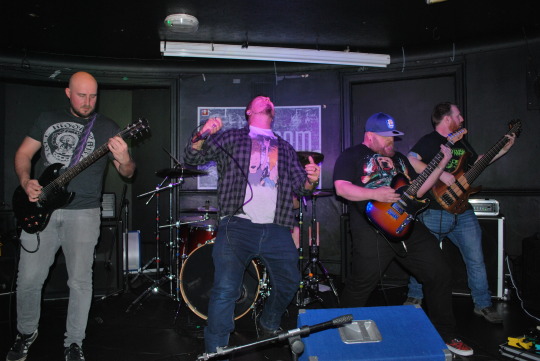
You guys have a new release coming out soon and a new tour next year. In hindsight, is there anything you'd have changed about the process?
Rob: "Phew, fair question that. Working on the details, in a studio when you've got a deadline in the studio and label commitments like "How's it sounding?" and y'know, general pressure to get it finished; it's all in those final little details."
Ed: "At the same time we did some of our greatest work under pressure. My personal favourite on the album is the one we put together right at the last minute, well, not the LAST minute but near."
It's normally always the way. When the pressure's on, some bands do their best stuff.
Mike: "We find that even though been playing these songs for about a year, you pick up little things and think, “Wish I'd done it like that instead,” but it's been great to get people in like Ten Foot Wizard and Boss Keloid to help us out."
ELDER DRUID
Golgotha by Elder Druid
At just after 11pm the monstrous apparition called ELDER DRUID took to the stage and detonated. Massive waves of Doom flood out from the barely-intact cabs as frontman Greg conjures spooky sounds from the Theremin, ghosting over a sea of intense riffing. Mass worship ensued as the congregation got down and dirty at the Druid's altar, the dual guitar assault of Jake and Mikey crushing everything in its wake.
Devastatingly heavy, Elder Druid came to preach The Old Religion and the flock lapped it up like manna from the heavens...pure class! I caught up with them before their set:

Good evening gentlemen. First question: what brought you to Coventry on a freezing cold night?
Greg: "Soozi from Heathen Mirth contacted us and got us onto the bill. We played a different venue last time we were in Coventry, but we heard that The Phoenix was the #1 place so we just had to be here."
Moving on to the new album. You're in the finishing stages now and it's due for release on 17th January. How have you found the recording?
Jake: "Yeah it's been great. Last time we had an engineer record and mix us but this time we've done it entirely by ourselves so it's good to have that freedom so we can get everything organised properly before we went in to record. you get to do it on your own timescale. Then it's good having the time to get all the details together, tinkering as it were."
There's a danger of "over-tinkering," though. Did you fall foul of it?
Mikey: "100% yeah, there is risk of being too critical, but I think we got it right this time. There's a few surprises on the album, Electric Piano and the Theremin to name a couple."
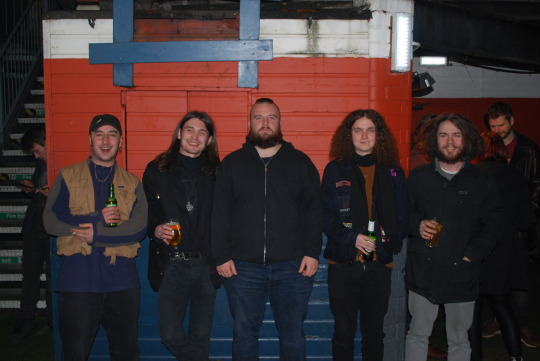
Is there anything you would have changed given the chance?
Greg: "The whole band" and laughs.
Dale (bass): "Better equipment would be nice. When you have the best gear etc it makes a big difference to the sound and inevitably it would be nicer to work with, but what's come out the other end we're really happy with it."
You can always ask Slomatics if you could borrow some of theirs?
Mikey: "Yeah, like can we borrow a riff off you please?" they all crack up.
What's the plan for 2020?
Brien (drums): "The launch day gig will be @ Voodoo in Belfast on the 17th Jan and the day after @ Fibber McGee's in Dublin then we're playing a festival in May over in Antrim, then we're heading over to play at Stonebaked Festival in Leeds, (Formerly BOOM fest) which we're really up for."
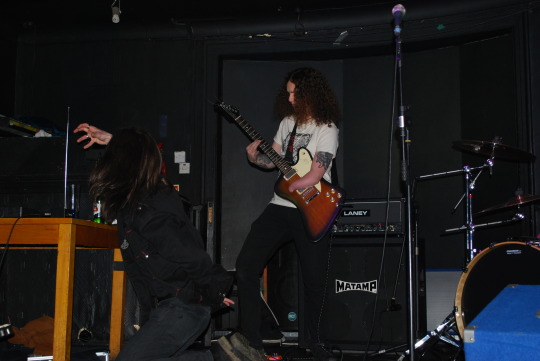
What was the last piece of equipment you had to kick to get working?
Mikey: "Greg."
Jake: "Funny you should say that...one of the amps blew up last night, but I managed to sell it on eBay." (laughs)
Any message for the fans?
Brien: "We don't have fans."
Greg:" Anyone out there who likes what we do, thank you!"
Thanks guys, it's been a pleasure!
Jake: "Thank you and thanks to Billy and Doomed and Stoned for looking after us."
#D&S Concert Review#Elder Druid#Barbarian Hermit#Slowbro#Satlan#Coventry#England#UK#doom#sludge#metal#stoner rock#Reek of STOOM#Doomed & Stoned
0 notes
Photo
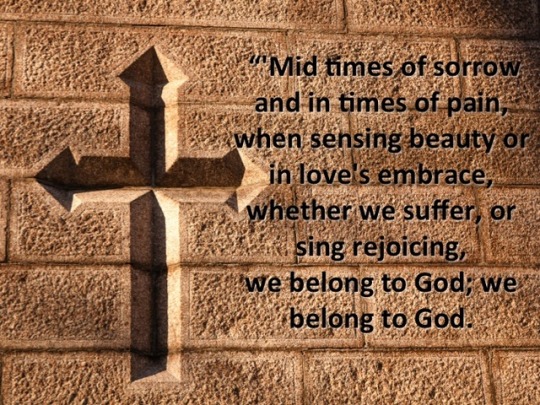
Belonging to God
When someone asks me about my personal relationship to God, my first spontaneous reply is a question: What do you mean by God? For decades, I have been speaking about religion with people all over the world, and I have learned one thing from this experience: the word God ought to be used with utmost caution if we want to avoid misunderstandings.
On the other hand, I find far-reaching agreement among human beings, once we reach that mystical core from which all religious traditions spring. Even those who cannot identify themselves with any organized religion are often deeply rooted in mystical experiences.
This is where I find my own reference point for the meaning of the term God. It needs to be anchored in that mystical awareness upon which all humans agree before they start talking about it.
In my best, my most alive moments—in my mystical moments, if you want—I have a profound sense of belonging. At those moments, I am aware of being truly at home in this universe. I know that I am not an orphan here. There is no longer any doubt in my mind that I belong to this Earth household, in which each member belongs to all others—bugs to beavers, black-eyed Susans to black holes, quarks to quails, lightning to fireflies, humans to hyenas and humus.
To say “yes” to this limitless mutual belonging is love. When I speak of God, I mean this kind of love, this great “yes” to belonging. I experience this love at one and the same time as God’s “yes” to all that exists (and to me personally) and as my own little “yes” to it all. In saying this “yes” I realize God’s very life and love within myself.
But there is more to this “yes” of love than a sense of belonging. There is always also a deep longing. Who has not experienced in love both the longing and the belonging? Paradoxically, these two heighten each other’s intensity. The more intimately we belong, the more we long to belong ever more fully. Longing adds a dynamic aspect to our “yes” of love. The fervor of our longing becomes the expression and the very measure of our belonging. Nothing is static here. Everything is in motion with a dynamism that is, moreover, deeply personal.
Where love is genuine, belonging is always mutual. The beloved belongs to the lover, as the lover belongs to the beloved. I belong to this universe and to the divine “Yes” that is its source, and this belonging is also mutual. This is why I can say “my God”—not in a possessive sense, but in the sense of a loving relatedness.
Now, if my deepest belonging is mutual, could my most fervent longing be mutual, too? It must be so.
Staggering though it is, what I experience as my longing for God is God’s longing for me. One cannot have a personal relationship with an impersonal force. True, I must not project on God the limitations of a person; yet, the Divine Source must have all the perfections of personhood. Where else would I have gotten them?
It makes sense, then, to speak of a personal relationship with God. We are aware of this—dimly at least—in moments in which we are most wakeful, most alive, most truly human. And we can cultivate this relationship by cultivating wakefulness, by living our human life to the full.
The Bible expresses these insights in the words, “God speaks.” Having been brought up in the biblical tradition, I am comfortable with its language, though I would be reluctant to impose it on anyone else. What matters is that we come to a shared understanding of what this, or any other, language wants to express. “God speaks” is one way of pointing toward my personal relationship with the Divine Source. This relationship can be understood as a dialogue. God speaks, and I am able to answer.
Wake Up Our Senses
But how does God speak? Through everything there is. Everything, every person, every situation, is ultimately Word. It tells me something and challenges me to respond. Each moment with all that it contains spells out the great “yes” in a new and unique way. By making my response, moment by moment, word by word, I myself am becoming the Word that God speaks in me and to me and through me.
This is why wakefulness is so preeminent a task. How can I give a full response to this present moment unless I am alert to its message? And how can I be alert unless all my senses are wide awake? God’s inexhaustible poetry comes to me in five languages: seeing, hearing, smelling, touching, and tasting. All the rest is interpretation—literary criticism, as it were, not the poetry itself. Poetry resists translation.
It can be fully experienced only in its original language. This is all the more true of the divine poetry of sensuousness. How then could I make sense of life if not through my senses?
When and to what do your senses respond most readily? If I ask myself this question, I think immediately of working in the garden. The hermitage where I am privileged to live for the better part of each year has a small garden. For fragrance, I grow jasmine, pineapple mint, sage, thyme, and eight different kinds of lavender. What abundance of delightful smells on so small a patch of ground! And what variety of sounds: spring rain, autumn wind, all year round the birds—mourning dove, blue jay, and wren; the hawk’s sharp cry at noon and the owl’s hooting at nightfall—the sound the yard-broom makes on gravel, wind chimes, and the creaking garden gate.
Who could translate the taste of strawberry or fig into words? What an infinite array of things to touch, from the wet grass under my bare feet in the morning, to the sun-warmed boulders against which I lean when the evening turns cool. My eyes go back and forth between the near and the far: the golden metallic beetle lost among rose petals; the immense expanse of the Pacific, rising from below the cliff on which this hermitage is perched to the far-off horizon where sea and sky meet in mist.
Yes, I admit it. To have a place of solitude like this is an inestimable gift. It makes it easy to let the heart expand, to let the senses wake up, one by one, to come alive with fresh vitality. Yet, whatever our circumstances, we need to somehow set aside a time and a place for this kind of experience. It is a necessity in everyone’s life, not a luxury. What comes alive in those moments is more than eyes or ears; our heart listens and rises to respond. Until I attune my senses, my heart remains dull, sleepy, half dead. In the measure to which my heart wakes up, I hear the challenge to rise to my responsibility.
Stay Alert
We tend to overlook the close connection between responsiveness and responsibility, between sensuousness and social challenge. Outside and inside are of one piece. As we learn to really look with our eyes, we begin to look with our heart also. We begin to face what we might prefer to overlook, begin to see what is going on in this world of ours. As we learn to listen with our ears, our heart begins to hear the cry of the oppressed.
We might begin to smell that “something is rotten in the state of Denmark.” We might sit down at table and taste the sweet and salty tears of the exploited which we import together with coffee and bananas. To be in touch with one’s body is to be in touch with the world—that includes the Two-Thirds World and all other areas with which our dull hearts are conveniently out of touch. No wonder that those in power, those interested in maintaining the status quo, look askance at anything that helps people come to their senses.
In my travels I notice how easy it is to lose attentiveness. Oversaturation of our senses tends to dim our alertness. A deluge of sense impressions tends to distract the heart from single-minded attention. This gives me a new appreciation for the hermitage, a fresh understanding of what solitude is all about. The hermit—the hermit in each of us—does not run away from the world, but seeks that Still Point within, where the heartbeat of the world can be heard. All of us—each in a different measure—have need of solitude, because we need to cultivate mindfulness.
The Practice of Gratefulness
How shall we do this in practice? Is there a method for cultivating mindfulness? Yes, there are many methods. The one I have chosen is gratefulness. Gratefulness can be practiced, cultivated, learned. And as we grow in gratefulness, we grow in mindfulness.
Before I open my eyes in the morning, I remind myself that I have eyes to see, while millions of my brothers and sisters are blind—most of them on account of conditions that could be improved if our human family would come to its senses and spend its resources reasonably, equitably. If I open my eyes with this thought, chances are that I will be more grateful for the gift of sight and more alert to the needs of those who lack that gift. Before I turn off the light in the evening, I jot down in my pocket calendar one thing for which I have never before been grateful. I have done this for years, and the supply still seems inexhaustible.
Gratefulness brings joy to my life. How could I find joy in what I take for granted? So I stop “taking for granted,” and there is no end to the surprises I find. A grateful attitude is a creative one, because, in the final analysis, opportunity is the gift within the gift of every given moment. Mostly this means opportunities to see and hear and smell and touch and taste with pleasure. But once I am in the habit of availing myself of opportunities, I will do so even in unpleasant situations creatively. But most importantly, gratefulness strengthens that sense of belonging which I mentioned at the very beginning.
There is no closer bond than the one which gratefulness celebrates, the bond between giver and thanksgiver. Everything is gift. Grateful living is a celebration of the universal give-and-take of life, a limitless “yes” to belonging. Can our world survive without it? Whatever the answer, one thing is certain: to say an unconditional “yes” to the mutual belonging of all beings will make this a more joyful world. This is the reason why Yes is my favorite synonym for God.
Brother David Steindl-Rast has been a Benedictine monk, since 1953, of Mount Saviour Monastery, in New York. He has written numerous books and articles, produced videos and audios, and is well known for his TED talk on gratefulness. This article is an excerpt from his new book, The Way of Silence: Embracing the Sacred in Daily Life.
1 note
·
View note